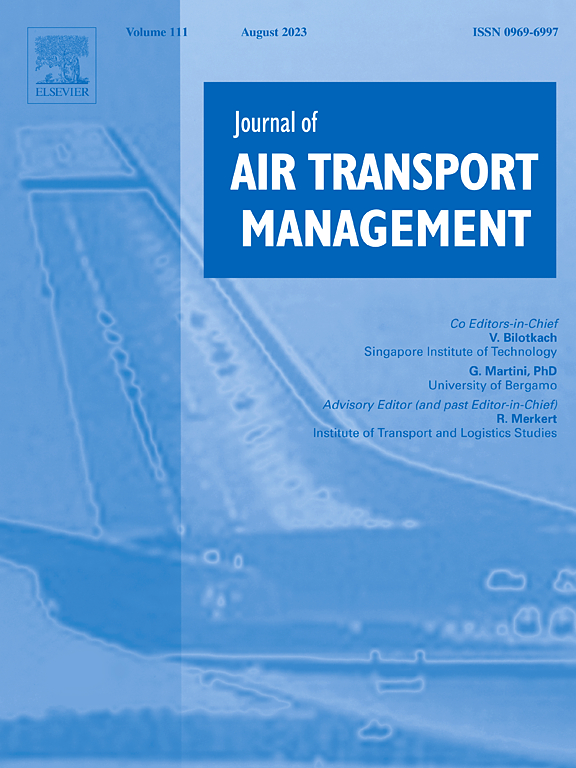Time series prediction of airport operational resilience under severe weather conditions
IF 3.6
2区 工程技术
Q2 TRANSPORTATION
引用次数: 0
Abstract
Airport operational resilience is a crucial metric reflecting an airport’s capacity to adapt to external shocks, essential for maintaining safety and operational efficiency. While there has been research on airport resilience under various severe weather conditions, the specific contributing factors and their impacts remain inadequately explored. This study develops a comprehensive index system that integrates airport performance and meteorological data, using a random forest algorithm to quantify the influence of various factors on airport resilience across five types of severe weather. Furthermore, a PatchTST(Patch time series Transformer)-based time series model improved by the Cauchy loss function is proposed to accurately predict airport operational resilience. Focusing on severe weather events during the period from January 2023 to July 2024 at Dallas-Fort Worth International Airport in the United States. To mitigate multicollinearity, variables with high Pearson correlation and variance inflation factor (VIF) values were removed prior to analysis. Feature importance results reveal that hourly flight movements (HFM) consistently hold the highest importance across weather types, while temperature (TEMP), relative humidity (RHUM) and air pressure (PRES) exhibit relatively higher meteorological influence despite limited overall impact. The optimal Cauchy-PatchTST model, with a look-back window of and a forecast length of , outperforms the traditional PatchTST model with MSE loss, three Transformer-based models and other optimized machine learning algorithms, achieving a 15.49% to 94.10% reduction in MAE on the test set. This study provides critical indicator analysis for airports across various severe weather conditions and offers reliable resilience data to support future operations management.
恶劣天气条件下机场运行弹性的时间序列预测
机场运营弹性是反映机场适应外部冲击能力的关键指标,对保持安全和运营效率至关重要。虽然对各种恶劣天气条件下的机场弹性进行了研究,但具体的影响因素及其影响仍未得到充分探讨。本研究开发了一个综合指标体系,将机场性能和气象数据整合在一起,使用随机森林算法量化各种因素对五种类型恶劣天气下机场恢复力的影响。在此基础上,提出了一种基于Patch时间序列变压器(Patch time series Transformer)的时间序列模型,并对其进行了柯西损失函数的改进,以准确预测机场运行弹性。重点关注2023年1月至2024年7月期间在美国达拉斯-沃斯堡国际机场发生的恶劣天气事件。为了减轻多重共线性,在分析之前去除具有高Pearson相关性和方差膨胀因子(VIF)值的变量。特征重要性结果显示,每小时飞行运动(HFM)在各种天气类型中始终保持最高的重要性,而温度(TEMP)、相对湿度(RHUM)和气压(PRES)表现出相对较高的气象影响,尽管总体影响有限。最优Cauchy-PatchTST模型的回溯窗口为L=36,预测长度为T=1,优于传统的带有MSE损失的PatchTST模型、基于三个变压器的模型以及其他优化的机器学习算法,在测试集上MAE降低了15.49% ~ 94.10%。该研究为各种恶劣天气条件下的机场提供了关键指标分析,并提供了可靠的弹性数据,以支持未来的运营管理。
本文章由计算机程序翻译,如有差异,请以英文原文为准。
求助全文
约1分钟内获得全文
求助全文
来源期刊

Journal of Air Transport Management
TRANSPORTATION-
CiteScore
12.40
自引率
11.70%
发文量
97
期刊介绍:
The Journal of Air Transport Management (JATM) sets out to address, through high quality research articles and authoritative commentary, the major economic, management and policy issues facing the air transport industry today. It offers practitioners and academics an international and dynamic forum for analysis and discussion of these issues, linking research and practice and stimulating interaction between the two. The refereed papers in the journal cover all the major sectors of the industry (airlines, airports, air traffic management) as well as related areas such as tourism management and logistics. Papers are blind reviewed, normally by two referees, chosen for their specialist knowledge. The journal provides independent, original and rigorous analysis in the areas of: • Policy, regulation and law • Strategy • Operations • Marketing • Economics and finance • Sustainability
 求助内容:
求助内容: 应助结果提醒方式:
应助结果提醒方式:


